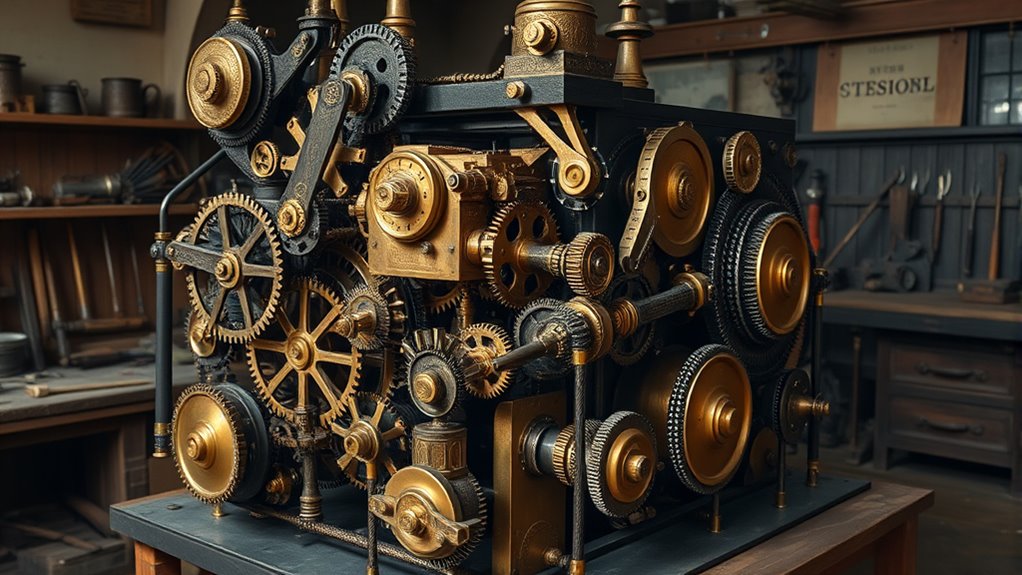Babbage’s Analytical Engine, designed in the Victorian era, is considered the first modern computer. It combined gears, levers, and punched cards to perform complex calculations automatically. It introduced key ideas like programmability and separate storage for instructions, foreshadowing today’s software. While never fully built in his lifetime, its innovative design influenced future computers and demonstrated the potential of mechanical, programmable automation. Exploring its details reveals how it shaped the history of computing.
Key Takeaways
- The Analytical Engine, designed by Charles Babbage, is considered the first concept of a modern, programmable computer from the Victorian era.
- It featured mechanical components like gears, levers, and punched cards, enabling complex calculations and modular repairs.
- The machine used punched cards inspired by Jacquard loom patterns, introducing the idea of programmable instructions and software.
- Functioning as an early CPU, it guided operations mechanically and could handle various problems beyond basic arithmetic.
- Although never fully built, the Analytical Engine influenced future computer design and marked a pivotal step toward automation.

Have you ever wondered what the first concept of a modern computer looked like? The answer lies in Charles Babbage’s Analytical Engine, a pioneering machine from the Victorian era that aimed to perform complex calculations automatically. Unlike earlier calculating devices, this machine was designed to be programmable, making it a true predecessor of today’s computers. Its mechanical design was intricate, featuring gears, levers, and punched cards, all arranged to allow for flexible operations. You could think of it as the blueprint for modern computing, where hardware and software work together seamlessly. Babbage envisioned a machine that could handle not just simple arithmetic, but a wide range of problems, all controlled through a series of instructions.
The Analytical Engine was the Victorian ancestor of modern, programmable computers.
At the core of the Analytical Engine was its innovative approach to programming. Babbage didn’t use code in the way we do today, but he created a system of punched cards that dictated the machine’s operations. These cards, inspired by the Jacquard loom’s weaving patterns, served as the first concept of a programming language. With them, you could set the machine to perform different calculations without physically altering its mechanical parts. This concept of storing instructions separately from the machine’s hardware was revolutionary, allowing for a level of flexibility that was unprecedented at the time. It was fundamentally the first step toward software, giving the machine a degree of adaptability that was previously thought impossible.
The mechanical design of the Analytical Engine was remarkably sophisticated for its era. It comprised a mill (the calculator), a store (memory), and an input/output system. The design incorporated a control mechanism that could interpret the punched card instructions, guiding the machine’s operations step-by-step. You could imagine this as a kind of early central processing unit (CPU), orchestrating calculations with precision. Babbage’s meticulous planning aimed to make the machine modular, so parts could be repaired or upgraded. Although the full machine was never built during his lifetime, its design demonstrated the potential of mechanical computation and set the groundwork for future computer development. The programmable nature of the engine was a groundbreaking feature that foreshadowed modern computer architecture.
In fundamentally, Babbage’s Analytical Engine embodied the fusion of mechanical design and programmable instructions, laying the foundation for the digital age. It was a machine that could be instructed to do different tasks through its programming language, all within a robust mechanical framework. This visionary approach marked a decisive step away from manual calculations toward automated, programmable machines. Even today, the concepts embedded in Babbage’s work continue to influence how we think about computers, reminding us of the Victorian machine that aimed to automate the future.
Frequently Asked Questions
Could Babbage’s Analytical Engine Be Built With Modern Technology?
Yes, you could build Babbage’s Analytical Engine today using modern technology, ensuring historical accuracy and technical feasibility. Advances in microelectronics, materials, and programming make it possible to recreate the original design with precision. You’d be able to develop a functioning replica that respects the Victorian-era concept while benefiting from today’s engineering. This project would showcase how historical ideas can be brought to life with current tech, blending past innovation with modern capabilities.
How Did the Analytical Engine Influence Today’s Computers?
You see, the Analytical Engine’s historical significance lies in its innovative design concepts, like programmability and the use of punched cards. These ideas laid the foundation for modern computers, inspiring later technological advancements. Its legacy persists in the development of digital computers, influencing how we process information today. The engine’s pioneering approach continues to shape computer architecture, making it a essential milestone in technological progress.
Were There Any Prototypes or Partial Models Created During Babbage’s Time?
You’d be amazed to learn that early mechanical models and incomplete prototypes of the Analytical Engine actually existed during Babbage’s time. These early efforts, though rudimentary, showcased groundbreaking ideas for computing. While no fully functional machine was built, these prototypes laid the foundation for modern computers. They proved that even in its infancy, the concept of programmable machines was possible, igniting a technological revolution that still influences us today.
What Were the Main Challenges Faced in Developing the Engine?
You face engineering hurdles and funding difficulties while developing the engine. Babbage struggles to perfect intricate mechanical parts, ensuring precision and reliability. Limited financial support hampers progress, delaying construction and testing. You also contend with technological limitations of the era, which restrict design innovations. These challenges make it tough to turn the theoretical design into a functional machine, slowing down advancements and causing frustration in bringing the Analytical Engine to life.
Did Babbage’s Engine Ever Get Fully Operational?
You’ll find that Babbage’s engine never became fully operational due to engineering limitations and the quest for historical accuracy. Despite groundbreaking designs, the technology of his time couldn’t support the complex mechanical parts needed for full functionality. He made significant progress, but the engine remained incomplete. Today, it stands as a remarkable concept that influenced future computing, even though it never ran as intended during his lifetime.
Conclusion
You might find it fascinating that Charles Babbage’s Analytical Engine, built in the 1830s, was designed to perform 1,000 calculations per second—way ahead of its time. Although it was never completed, this Victorian computer laid the groundwork for modern computers. Its innovative concepts influenced future technology, proving that even in the 19th century, pioneering ideas could shape the digital world we live in today. The Analytical Engine truly was a visionary leap forward.








